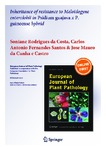Use este identificador para citar ou linkar para este item:
http://www.alice.cnptia.embrapa.br/alice/handle/doc/1056536Registro completo de metadados
| Campo DC | Valor | Idioma |
|---|---|---|
| dc.contributor.author | COSTA, S. R. da | pt_BR |
| dc.contributor.author | SANTOS, C. A. F. | pt_BR |
| dc.contributor.author | CASTRO, J. M. da C. e | pt_BR |
| dc.date.accessioned | 2016-11-17T11:11:11Z | pt_BR |
| dc.date.available | 2016-11-17T11:11:11Z | pt_BR |
| dc.date.created | 2016-11-17 | pt_BR |
| dc.date.issued | 2016 | pt_BR |
| dc.identifier.citation | European Journal of Plant Pathology, v. 145, n. 4, 2016. | pt_BR |
| dc.identifier.uri | http://www.alice.cnptia.embrapa.br/alice/handle/doc/1056536 | pt_BR |
| dc.description | Inheritance of the resistance to nematodes has been studied on many different crops, however to our knowledge, no data are available for guava species. The basic genetic resistance parameters to Meloidogyne enterolobii are estimated in the current research in order to guide the development of genotypes resistant to the pathogen. The parental plants, F1 and F2 from a Psidium guajava x P. guineense cross were assessed for the presence or absence of galls and for the number of eggs and juveniles in the root system at the 120th and 240th days after inoculation with 10,000 eggs and juve- niles of the nematode. At the age of nine years, the P. guineense plant remained without nematode attack symptoms, whereas the maternal plant was destroyed by the pathogen. The F1 generation showed 270 plants with reproduction factor (RF) <0.322, and there were tiny galls in only 16 plants. The segregation for the presence or absence of galls in the root system in generation F2 was 9:7, wherein the χ2 values were 0.78 and 2.66, respectively, at the 120th and 240th days after inoculation, whereas the segregation for RF was 15:1, wherein the χ2 values were 2.76 and 1.18, respectively, at the 120th and 240th days. These results indicate epistatic interaction between two genes: in RF < 1 only one allele sets the resistance to the pathogen. The broad sense heritability of RF, estimated to the two assessments was 0.97, and it also indicates a simple inheritance of resistance to M. enterolobii. | pt_BR |
| dc.language.iso | eng | eng |
| dc.rights | openAccess | eng |
| dc.subject | Meloidogyne enterolobii | pt_BR |
| dc.subject | Melhoramento genético | pt_BR |
| dc.subject | Guava | pt_BR |
| dc.subject | Nematode | pt_BR |
| dc.title | Inheritance of resistance to Meloidogyne enterolobii in Psidium guajava x P. guineense hybrid. | pt_BR |
| dc.type | Artigo de periódico | pt_BR |
| dc.date.updated | 2017-02-15T11:11:11Z | pt_BR |
| dc.subject.thesagro | Goiaba | pt_BR |
| dc.subject.thesagro | Nematoíde | pt_BR |
| dc.subject.nalthesaurus | Heritability | pt_BR |
| riaa.ainfo.id | 1056536 | pt_BR |
| riaa.ainfo.lastupdate | 2017-02-15 | pt_BR |
| dc.identifier.doi | 10.1007/s10658-016-1098-0 | pt_BR |
| dc.contributor.institution | SONIANE RODRIGUES DA COSTA, UEFS; CARLOS ANTONIO FERNANDES SANTOS, CPATSA; JOSE MAURO DA CUNHA E CASTRO, CPATSA. | pt_BR |
| Aparece nas coleções: | Artigo em periódico indexado (CPATSA)  | |
Arquivos associados a este item:
| Arquivo | Descrição | Tamanho | Formato | |
|---|---|---|---|---|
| CarlosAntonio2016.pdf | 1,59 MB | Adobe PDF |  Visualizar/Abrir |









